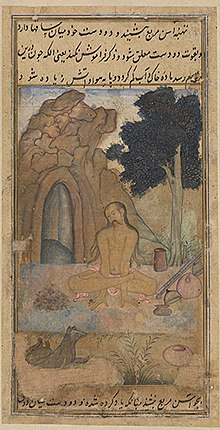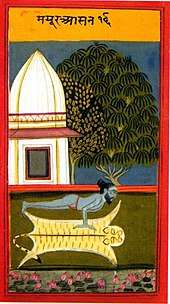Kukkutasana
Kukkutasana (Sanskrit: कुक्कुटासन; IAST: Kukkuṭāsana), Cockerel Pose, or Rooster Posture[2] is an asana in hatha yoga and modern yoga as exercise.[3]


Etymology and origins
The name comes from the Sanskrit words kukkuṭā meaning "cockerel"[4] and asana (आसन) meaning "posture" or "seat".[5]
The asana is described in medieval hatha yoga texts including the 7th century Ahirbudhnya Saṃhitā,[6] the 13th century Vasishtha Samhita,[7] the 15th century Haṭha Yoga Pradīpikā 1.23, the 17th century Gheraṇḍa Saṃhitā 2.31, and the Bahr al-hayat c. 1602.[8]
Description
The pose is entered from Padmasana (Lotus Position). The hands are threaded through behind the knees, and the weight of the body is supported by the hands pressed down on the floor, the arms straight.[9]
Variations
Variations include Urdhva Kukkutasana (upwards) and Parsva Kukkutasana (sideways).[9][10]
Claims
Twentieth century advocates of some schools of yoga, such as B. K. S. Iyengar, made claims for the effects of yoga on specific organs, without adducing any evidence.[11][12] Iyengar claimed that this pose "strengthens the wrists and abdominal walls."[13]
See also
- List of asanas
- Uttana Kurmasana
References
- Maehle, Gregor (2007). Ashtanga Yoga: Practice and Philosophy. New World Library. p. 98. ISBN 978-1-57731-606-0.
- Sharma, S. K.; Singh, Balmukand (1998). Yoga: a guide to healthy living. Barnes & Noble. p. 31. ISBN 978-0-7607-1250-4.
- Nardi, Isabella (2006). The theory of Citrasūtras in Indian painting: a critical re-evaluation of their uses and interpretations. Taylor & Francis. p. 102. ISBN 978-0-415-39195-5.
- Sinha, S. C. (1 June 1996). Dictionary of Philosophy. Anmol Publications. p. 18. ISBN 978-81-7041-293-9.
- Mallinson, James (9 December 2011). "A Response to Mark Singleton's Yoga Body by JamesMallinson". Retrieved 4 January 2019. revised from American Academy of Religions conference, San Francisco, 19 November 2011.
- Mallinson & Singleton 2017, pp. 87–88, 104–105.
- Gwaliyari, Muhammad Ghawth; Ernst, Carl W. (trans.) (2013) [1602]. Yoga: The Art of Transformation | Chapter 4 of the Bahr al-hayat, by Muhammad Ghawth Gwaliyari.
- Iyengar, B. K. S. (1979) [1966]. Light on Yoga: Yoga Dipika. Unwin Paperbacks. pp. 140–141, 320–325.
- Birch, Beryl Bender (28 August 2007). "Asana Column: Urdhva Kukkutasana (Upward Cock Pose)". Yoga Journal.
- Newcombe 2019, pp. 203-227, Chapter "Yoga as Therapy".
- Jain 2015, pp. 82–83.
- Iyengar 1979, p. 141.
Sources
- Iyengar, B. K. S. (1979) [1966]. Light on Yoga: Yoga Dipika. Unwin Paperbacks. ISBN 978-1855381667.CS1 maint: ref=harv (link)
- Jain, Andrea (2015). Selling Yoga : from Counterculture to Pop culture. Oxford University Press. ISBN 978-0-19-939024-3. OCLC 878953765.CS1 maint: ref=harv (link)
- Mallinson, James; Singleton, Mark (2017). Roots of Yoga. Penguin Books. ISBN 978-0-241-25304-5. OCLC 928480104.CS1 maint: ref=harv (link)
- Newcombe, Suzanne (2019). Yoga in Britain: Stretching Spirituality and Educating Yogis. Bristol, England: Equinox Publishing. ISBN 978-1-78179-661-0.CS1 maint: ref=harv (link)
_from_Jogapradipika_1830_(detail).jpg)

